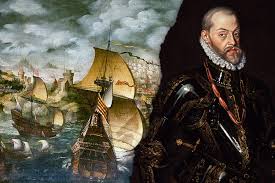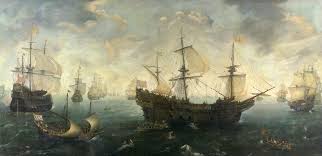Your basket is currently empty!
Introduction
The year 1588 marks one of the most iconic moments in European maritime history: the failed Spanish invasion of England. Long taught as a triumph of English seamanship and strategy, modern historians offer a more nuanced view. While the English navy did harass the Armada, it was ultimately not gunfire, but the fury of nature that dealt the most devastating blow. The so-called “Invincible Armada” was undone not by battle—but by brutal Atlantic storms.
Philip II’s Grand Ambition

At the heart of the conflict was Philip II of Spain, a devout Catholic determined to overthrow Protestant Queen Elizabeth I and restore Catholic dominance in England. Backed by papal blessing and a powerful empire, Philip launched an ambitious naval campaign.
The Armada consisted of approximately 130 ships, including war galleons, supply transports, and troop carriers—altogether carrying over 30,000 men and thousands of cannons. The plan was to sail through the English Channel, link up with the Duke of Parma’s army in the Spanish Netherlands, and launch a full-scale invasion of southern England.
Skirmishes in the Channel
As the Armada entered the English Channel, it was met by the English navy under Lord Howard of Effingham and Sir Francis Drake. Several skirmishes followed, most notably the Battle of Gravelines.
The English ships, faster and more maneuverable, managed to disrupt the Spanish formation, but contrary to popular myth, they did not destroy the fleet. Spanish ships, built for defense, were hard to sink. Moreover, the English ran low on gunpowder and cannonballs, limiting their ability to press a decisive attack.
The Protestant Wind: Nature Turns the Tide
Following the naval clashes, the Spanish commanders, unable to regroup with Parma, chose to retreat by sailing north around Scotland and Ireland. It was here that disaster truly struck.
In what Protestant England later called the “Protestant Wind,” the Armada faced a series of powerful and relentless storms. Ships were blown off course, wrecked on rocky shores, or scattered across the North Atlantic. Rudders were lost, sails shredded, and hulls breached. Dozens of ships sank without ever encountering enemy fire.
Thousands of Spanish sailors and soldiers drowned, starved, or froze to death on the windswept coasts of Ireland and Scotland. Local resistance and a lack of supplies ensured that few survivors ever returned home.
Aftermath and Historical Impact
Out of roughly 130 original ships, only 60 to 65 made it back to Spain, many severely damaged. As many as 20,000 men perished, not from English cannonballs, but from the indifference of the sea.
The defeat of the Spanish Armada marked a significant turning point in naval warfare and European politics. While Spain remained a dominant global power, its aura of invincibility was shattered. England, meanwhile, emerged emboldened and entered a golden age of maritime expansion.
Yet the popular narrative often overstates England’s naval prowess and understates the role of weather. The outcome of 1588 reminds us that in war, even the mightiest fleets can be undone by forces far beyond human control.
Conclusion
The Spanish Armada’s failure was not merely a military defeat—it was a humbling display of nature’s supremacy over human ambition. As much as historians credit England’s tactics, it was the unpredictable Atlantic storms that shattered Philip II’s dream of conquest. The legend of 1588 lives on not just as a story of naval warfare, but as a cautionary tale about the power of the sea.
Explore more historical war machines on our Legends and Myths site.

